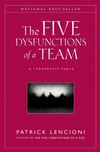 The Five Dysfunctions of a Team: A Leadership Fable
The Five Dysfunctions of a Team: A Leadership Fable
Author: Patrick M. Lencioni
Publisher: Jossey-Bass
Length: 229 Pages
The book is smart, easy to read, understand and is meant to be a fictional story with current situational relevance which can be shared with others and easily translated to the organization. Storytelling is a long lost art that most present organizations fail to recognize for its importance leading to knowledge transfer and learning associated with management principles lessons.
A story allows sharing at a higher level because the author has placed themselves in the position of vulnerability, while the reader gets to participate as a safe traveler in the events of the main character (Kathryn) as she struggles to put together a high performing Silicon Valley team at DecisionTech which is in trouble.
She unveils one-by-one the Five Dysfunctions for her team which are in order...
- Absence of Trust
- Fear of Conflict
- Lack of Commitment
- Avoidance of Accountability
- Inattention to Results
These dysfunctions are presented as human behavioral tendencies that cause disruptive chaos and people issues. They are illustrated as stepping stones to success which need to be followed in a specific order to get the desired results. The Model for them is pyramid shape with the essential Trust component as the base.
Anyone who has had the challenge of putting together high performance teams understands the importance and ranking of the skill sets provided in the story and the investment in time and energy required. Additionally, Organizational Development people will acknowledge that each of the skills in the Journey is critical and required for current business enterprise success and building a healthy team.
Systems thinkers will appreciate the read as a mix of organizational chaos and events that are typical to the challenges faced daily while at the same time understanding the need to move forward bringing some sense of interconnected structure to the team. Breaking down the "Five Dysfunctions" and understanding the sequence necessary to prevent them provides a roadmap to success which can be built systemically over time.
As the story evolves the reader can find many overlaps into their current team and the events that may have happened previously to them. As the story ends the book unveils a concise second section in the end that provides crib notes and suggestions for implementation.
The book should be provided to all managers and leaders who are looking to create a higher level of extraordinary awareness and build teams that are moving forward in a positive direction. It is the first of three in a series that includes the Five Temptations of a CEO & The Four Obsessions of an Extraordinary Executive. |
Published In: October 2006, In2In Thinking Network |
 The Five Dysfunctions of a Team: A Leadership Fable
The Five Dysfunctions of a Team: A Leadership Fable The Five Dysfunctions of a Team: A Leadership Fable
The Five Dysfunctions of a Team: A Leadership Fable